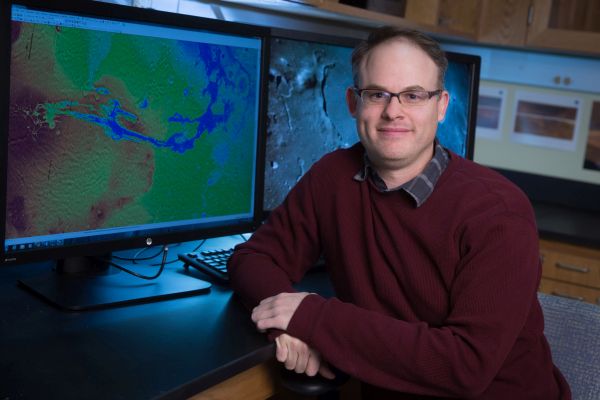Proposal F18 Faculty Warner
Sponsored Research Newsletter Fall 2018

Faculty Focus - Nick Warner, Geological Sciences, NASA's Mars InSight Mission Grant
 A four-year grant from the National Aeronautics and Space Administration (NASA) will support a SUNY Geneseo faculty member’s appointment as a NASA Participating Scientist (equivalent of PI), making him the geology theme leader of the Mars InSight (Interior Exploration Using Seismic Investigations, Geodesy and Heat Transport) mission team with both operational and data analyses responsibilities. InSight is a robotic lander that was launched from California on May 5th. To see the launch, visit https://www.youtube.com/watch?v=NuDq3n_VKyI. InSight is expected to land on the surface of Mars on November 26th. Once there, it will deploy a seismometer and burrow a heat probe.
A four-year grant from the National Aeronautics and Space Administration (NASA) will support a SUNY Geneseo faculty member’s appointment as a NASA Participating Scientist (equivalent of PI), making him the geology theme leader of the Mars InSight (Interior Exploration Using Seismic Investigations, Geodesy and Heat Transport) mission team with both operational and data analyses responsibilities. InSight is a robotic lander that was launched from California on May 5th. To see the launch, visit https://www.youtube.com/watch?v=NuDq3n_VKyI. InSight is expected to land on the surface of Mars on November 26th. Once there, it will deploy a seismometer and burrow a heat probe.
Assistant Professor of Geological Sciences Nick Warner’s mission team research will help us understand the formation and evolution of Mars and all rocky planets, including Earth. The grant pays for: undergraduate research assistants; travel costs for Dr. Warner to attend pre- and post-launch meetings at the Jet Propulsion Laboratory (JPL); travel to JPL for 58 days of research, beginning with InSight’s landing on Mars; and conference travel support for the PI and students.
The mission will allow Dr. Warner to remotely investigate the geology of the surface and subsurface of Mars and to assess its modern and ancient surface processes. This will build our understanding of the geologic and climate history of the planet. Geologic investigations will play a critical operational role in the mission. As part of the Instrument Site Selection Working Group (ISSWG), Dr. Warner will evaluate landscape morphometry (e.g. slope, relief, rock size) and terrains (e.g. rocks, bedforms, craters) in the ~3.4 m2 workspace in front of the lander. The team will determine the terrain and soil/regolith (layer of unconsolidated rocky material covering bedrock) characteristics in the workspace. They will monitor active surface processes, such as wind and dust accumulation, to see how these elements affect instrument operation, lander battery life, and modern surface process rates.
Dr. Warner was chosen, in part, for his past experience at his previous post at JPL. His familiarity with the local geology will be critical for rapid analyses of the workspace. His research will produce high-level data products, including co-registered maps, geospatial data products (e.g. hillshade maps, slope maps), morphometric data, and stratigraphic logs (among others). For more about InSight, visit https://mars.nasa.gov/insight.